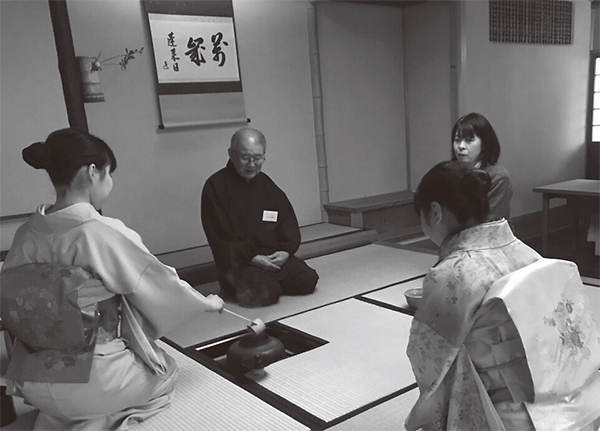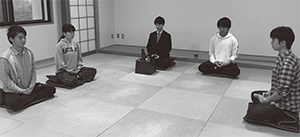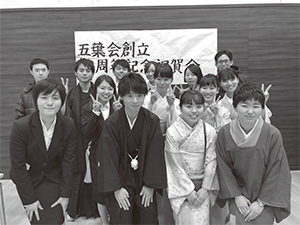Held a Celebration for the 90th Anniversary of Goyokai
Unexpected presence behind the scenes results in the ultimate experience Wiping away worldly thoughts through Zen meditation in today’s era of information overload
Yuri Hashimoto
4th year student, Faculty of Policy Studies

The Zen and tea ceremony club Goyokai (Culture Federation, Association of Student Clubs) celebrated the 90th anniversary of its founding in May, 2018. Goyokai was started in 1928 and has continued through the Showa Period and Heisei Period into the new Reiwa period. Yuri Hashimoto, a senior in the Faculty of Policy Studies, reports on how Goyokai has preserved tradition and holds activities in harmony with each era.
The Zen proverbs: Ikka goyou wo hiraku, kekka jinen to naru
May 15, 2018 was the 90th anniversary of Goyokai. We held a celebration on the Tama Campus of Chuo University on December 1, 2018.
The lively celebration was attended by about 40 people including alumni, distinguished guests, and current club members (students).
Goyokai was founded in 1928 by Professor Tetsuji Tatsuta, who taught college preparatory courses at Chuo University at that time. In addition to his academic activities, Professor Tatsuta was also diligent in teaching Zen.
It is said that Goyokai was started by Professor Tatsuta and five of his students. The name was derived from the Zen proverbs: Ikka goyou wo hiraku (when a flower opens, it has five petals), kekka jinen to naru (forming fruit that ripens on its own).
The meaning of these Zen proverbs is interpreted in different ways. Generally, it is thought to celebrate a thriving business and the prosperity of descendants.
Currently, Goyokai members consist of five male students and eight female students. Our club has a relaxed atmosphere without regard to age or seniority. Our main activity is Zen meditation and we also perform the tea ceremony. Some people may consider our club as somewhat unordinary.

The strong relationship with Buddhism and Zen meditation are accompanied by religious elements, and such relationship may make some students hesitant to join the club. However, in essence, Zen meditation is an opportunity for us to explore and understand ourselves.
Nowadays, the world is overflowing with vast amounts of information. Perhaps there is an even greater need to reflect upon ourselves without worldly thoughts?
Also, the increase in globalization and opportunities for intercultural exchanges in modern times has made it more important for Japanese people to study their own culture. Recently, a movie about the tea ceremony Nichinichi Kore Kojitsu (Every Day A Good Day) attracted great attention in Japan. The movie has been praised for how the interaction between the instructor and students in the tea ceremony class conveys the Japanese tradition and aesthetic sensibility.
Preparing for the celebration

Commemorative photograph with alumni and students in Goyokai
Once a week, club members gather in the club room of Building No. 4 on the Tama Campus to perform Zen meditation together.
Other than Goyokai members, I rarely have an opportunity to meet students who perform Zen meditation. However, when I visit a Zen Buddhist temple which is an important part of my daily life, a wide range of age groups from students to elderly individuals are participating in Zen meditation. Interacting with other people who are devoted to Zen is a wonderful stimulation to current members of Goyokai.
There are several alumni who have devoted themselves to Zen meditation after graduating from Chuo University and starting to work. Occasionally, alumni visit our club room and sit in Zen meditation with current Goyokai members. One appeal of Goyokai is that our long history has produced a strong connection with numerous alumni.
At the celebration in December, we set up a gallery exhibiting materials associated with Goyokai while holding Zen meditation gatherings, tea ceremonies, and lectures. These exhibits allowed alumni to reflect back on their university days. It was also a great opportunity for current students to reconfirm their connection with Goyokai and Chuo University.
Reflecting back, I am amazed that just a few club members were able to put together such a wonderful celebration. The date for the celebration had been decided in the middle of last July. At that time, I had almost finished my job search activities and life was returning to normal--and then Goyokai suddenly gave me the big responsibility of planning the celebration.
Honestly, I was obviously flustered. I had never prepared for such a celebration. I had no idea how to proceed and so many details to consider.
One difficulty that I encountered was preparing to serve as sekishu, the host of the tea ceremony. Sekishu is responsible for interacting with the shokyaku (the guest of honor seated in the best location) and for overseeing the proceedings of the tea ceremony.
I also encountered a number of other difficulties. For example, I had to be prepared to give satisfactory answers to questions from guests regarding the bowls in which tea was served, the hanging scroll in the tearoom, the name of flowers and vessels, and utensils used in the tea ceremony.
Leading up to the day of the celebration, I repeatedly confirmed the names of utensils so that I wouldn't forget. I also engaged in mental training while considering what topics to discuss with the shokyaku.
Although I was quite nervous on the day of the celebration, I felt relieved upon seeing the amicable atmosphere of the guests. I realized that I had been putting too much pressure on myself.
Thanks to assistance from our guests, I was able to smoothly run the tea ceremony. The experience taught me that the most important aspect of showing guests a good time is to enjoy yourself.
Holding the celebration taught me a great many things about Goyokai and Chuo University. In fact, Chuo University has a deep connection with the tea ceremony.
For example, do you know that a tearoom named Kohakuan is located in a corner of the Sakura Plaza on the Tama Campus?

Ichijugiri (bamboo) flower vessel: Made by Professor Kazue
Kohakuan was constructed about 20 years ago thanks mainly to the efforts of the late Professor Kyoichi Kazue, who served as an advisor to Goyokai. Professor Kazue taught in the Faculty of Letters and conducted research on the history of Japanese ethical thought and the tea ceremony.
The tearoom was named Kohakuan by tea master Jimyosai, the 14th Head of the Omotesenke Tea School and a graduate of Chuo University.
Chuo University has tea ceremony utensils made by Professor Kazue and a hanging scroll written by Jimyosai. During our celebration, we were able to borrow numerous famous works and produce an extraordinary tea ceremony.
Although I encountered many difficulties, I gained a great deal of knowledge through the celebration. I was also able to deepen my bond with senior students and younger students who cooperated to create a successful event. Ultimately, the experience was an essential part of my time at university.
I would like to take this opportunity to express my heartfelt gratitude to everyone who helped me hold the celebration.
Goyokai offers experience in Zen meditation and the tea ceremony. I highly recommend our club to anyone who wants to learn more about Japanese culture as part of becoming a global professional.
Wonderful experiences are waiting for you at Goyokai.
Academic environment of Chuo University in 1928 when Goyokai was founded
1926: From Kanda Nishiki-cho to Surugadai
In 1920, a comprehensive university consisting mainly of the Faculties of Law, Economics, and Commerce (former pre-war system of Chuo University) was relocated from Kanda Nishiki-cho to Surugadai. In 1949 after World War Two, Chuo University started operating under the new university system.
1928: Origin of Hakumon (White Gate), the symbol of Chuo University
Hakumon is a word which symbolizes Chuo University. The phrase is said to have originated from the lyrics of the student song from 1928: "Witness the dawn of the White Gate; hear the chorus resound throughout the sacred hall." (According to the Chuo University Guidebook 2019)








